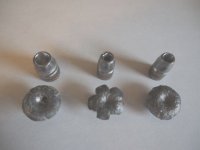OP
RGVshooter
Member
WHY push the envelope??? Surely you could find an acceptable accuracy sweet spot at a lower pressure. NO MAN POINTS for running the hottest loads. Got hot loads? Run them thru a STRONG/less valuable gun. ALSO look at what gun & barrel length they are testing those loads in. A 8" universal receiver is different from an alloy/light wt snub.
The test gun in the article was a Ruger LCR 38 special +P with a 1-7/8" barrel.

